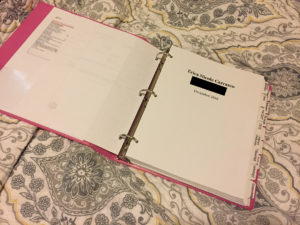Many times, doctors will tell you your medical diagnosis and it’s not necessarily what’s written on your official paperwork that goes to your insurance with your diagnosis code. A lot of doctors still use old language, names of illnesses that are out of date or just not used anymore when talking with you. It’s important to know the facts, for your own knowledge. Also, knowing current terminology is important to pass forward. We don’t want to be stuck with outdated information when talking to others.
I always keep a copy of my medical records on hand (in a nifty binder with tabs) because I have a rare condition. With Hemiplegic Migraine, I always get one of two looks: blank unknowingness or intrigued and possibly excited. The latter is probably because I’m in a larger city or at a headache specialist. I once had a doctor just stare at one of my attacks in the ER and say, “Fascinating!” Just so you know, my migraine attacks look like a stroke event with a seizure. Even if you don’t have a rare condition, it’s still important to know what’s going on. It is your life after all.
How to Find Your Diagnosis Code
In the following sections, I will explain to you who creates your diagnosis code and how it might be used. Below is an example of an ICD-10 code. You will see each character and number has a specific meaning. You can learn more about how to interpret the code after understanding why it important to you in the Important Links below..

Who is WHO and ICD
Have you ever heard of the World Health Organization (WHO)? Or maybe the International Statistical Classification of Diseases and Related Health Problems 10th Revision (ICD-10)? More than likely, you have heard WHO on the news. But what are they exactly? According to the WHO website, they are the “directing and coordinating authority on international health within the United Nations’ system.” WHO is also the author of the ICD-10. The ICD-10 is a classification of all diseases and you might see the associated codes on your medical records. They are classified with a diagnosis code.
These codes are what doctors and hospitals use to bill insurance companies. In an article written on Very Well Health earlier this year, written by Taynya Feke, MD, she explains how the wrong ICD diagnosis code can affect your care and your wallet. You can read more about her reasons here. Very important to know.
What to Do With Your ICD-10 Diagnosis Code
Many health conditions, like Migraine, have their own websites with their own classifications for each sub-type of illness. Within the Migraine community, health care professionals currently follow the International Classification of Headache Disorders 3rd Edition (ICHD-3). For one of the diseases I fight, Hemiplegic Migraine, I have an ICHD-3 code of 1.2.3.2 Sporadic hemiplegic migraine (SHM) and an ICD-10 diagnosis code of G43.105. How do I know this? I asked my doctor for my specific ICHD-3 code and compared it with the ICD-10 diagnosis code. If you have Migraine, there’s a handy cheat sheet the ICHD-3 geniuses put together here (PDF download).
Here are 3 ways to find out your diagnosis code:
- Ask your doctor during your visit. I can’t promise you they won’t get annoyed, but some may be happy to know you are interested in your health. Either way, it’s your medical history, ask if you feel comfortable.
- Ask the clerk on your way out of your visit. The doctor will have written your diagnosis code on the paperwork she is using to bill your insurance.
- Request a copy of your medical records. Most of the time there will be some type of document with your diagnosis listed. Sometimes you can get these securely, online through your doctor’s office.

Once you have your diagnois code, add it to your personal medical binder. It’s good to know and keep a record of them in case you are ever in the emergency room away from home or meeting with a new doctor. Just a quick tip an irritated Neurologist once suggested to me, keep a binder with the following:
- Emergency Contact information
- Insurance information
- Primary Care Doctor’s information
- Specialist’s information
- Latest doctor visit notes
- Latest test results (including labs and x-rays, CT, MRI, etc.)
- List of all current prescriptions with doses and strengths
- List of all past medications, doses, strengths, what side effects you had, and the reason you stopped taking them
- Description of what a typical “attack” looks like
- Anything you feel is important
I promise you, it works out well in most cases. I’ve used my binder when traveling and most of the physicians have looked through it and thanked me for being so organized and helpful. I can’t take the credit for being that smart, but I can take the credit for following through! Now that you know how to find your diagnosis codes, I hope you will begin to better understand your specific condition and arm yourself with knowledge. Don’t get stuck in the dark.
Oh, and in case you’re wondering why he was irritated, it’s because I have seen MANY doctors in my quest for a diagnosis. When trying to think of all my past medications and side effects from memory, he was flustered. Rightfully so. A doctor cannot do his best if he’s not working with the right information.
Important Links
- WHO: http://www.who.int/
- ICD-10 Code Browser: http://apps.who.int/classifications/icd10/browse/2015/en#/IX
- ICHD-3: https://www.ichd-3.org/
- ICHD-3 vs ICD-10: https://www.ichd-3.org/wp-content/uploads/2016/08/ICHD-3-Code-vs-ICD-10-NA-Code.pdf
What Can You Do
Do you have a medical binder like mine? Tag me in a pic on your social media sites! Just make sure to keep any confidential information blurred or colored out. Stay safe with your information online, it’s crazy out there!






Leave a Reply